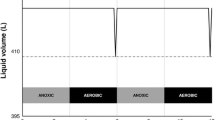Abstract
This paper describes a novel bioscrubber concept for biological flue gas desulfurization, based on the recycling of a cell suspension of sulfite/sulfate reducing bacteria between a scrubber and a sulfite/sulfate reducing hydrogen fed bioreactor. Hydrogen metabolism in sulfite/sulfate reducing cell suspensions was investigated using batch activity tests and by operating a completely stirred tank reactor (CSTR). The maximum specific hydrogenotrophic sulfite/sulfate reduction rate increased with 10% and 300%, respectively, by crushing granular inoculum sludge and by cultivation of this sludge as cell suspension in a CSTR. Operation of a sulfite fed CSTR (hydraulic retention time 4 days; pH 7.0; sulfite loading rate 0.5–1.5 g SO 2-3 l-1 d-1) with hydrogen as electron donor showed that high (up to 1.6 g l-1) H2S concentrations can be obtained within 10 days of operation. H2S inhibition, however, limited the sulfite reducing capacity of the CSTR. Methane production by the cell suspension disappeared within 20 days reactor operation. The outcompetition of methanogens in excess of H2 can be attributed to CO2 limitation and/or to sulfite or sulfide toxicity. The use of cell suspensions opens perspectives for monolith or packed bed reactor configurations, which have a much lower pressure drop compared to air lift reactors, to supply H2 to sulfite/sulfate reducing bioreactors.
Similar content being viewed by others
References
Alphenaar PA, Perez MC & Lettinga G (1993) The influence of substrate transport limitation on porosity and methanogenic activity of anaerobic sludge granules. Appl. Microbiol. Biotechnol. 39: 276–280
APHA-AWA-WPCF (1985) Standard Methods for the Examination of Water and Wastewater, 16th edn. APHA, Washington, USA
Athanassopoulos N, Kouinis J, Papadimitriou A & Koutinas AA (1989) Effect of high sulfite contents on anaerobic digestion of raisin-finishing wastewater. Biological Wastes 30: 53–60
Chuichulcherm S, Nagpal S, Peeva L & Livingston A (2001) Treatment of metal-containing wastewaters with a novel extractive membrane reactor using sulfate-reducing bacteria. J. Chem. Tech. Biotechnol. 76: 61–68
Colleran E, Finnegan S & Lens P (1995) Anaerobic treatment of sulphate-containing waste streams. Antonie van Leeuwenhoek 67: 29–46
De Smul A & Verstraete W (1999) The phenomenology and the mathematical modeling of the silicone-supported chemical oxidation of aqueous sulfide to elemental sulfur with ferric sulfate. J. Chem. Technol. Biotechnol. 74: 456–466
Eis BJ, Ferguson JF & Benjamin MM (1983) The fate and effect of bisulphate in anaerobic treatment. J. Water Pollut. Control Fed. 55: 1355–1365
Fedorovich V, Greben M, Kalyuzhnyi S, Lens P, Hulshoff Pol L & Lettinga G (2000) Use of membranes for hydrogen supply in a sulfate reducing reactor. Biodegradation 11: 295–303
Hellinga C, Schellen AAJC, Mulder JW, van Loosdrecht MCM & Heijnen JJ (1998) The sharon process: An innovative method for nitrogen removal from ammonium-rich waste water. Water Sci. Technol. 37(9): 135–142
Hulshoff Pol L, Lens P, Stams AJM & Lettinga G (1998) Anaerobic treatment of sulfate-rich wastewaters. Biodegradation 9: 213–224
Janssen AJH, Dijkman H & Janssen G (2000) Novel biological processes for the removal of H2S and SO2 from gas streams. In: Lens PNL & Hulshoff Pol LW (Eds) Environmental Technologies to Treat Sulfur Pollution — Principles and Engineering (pp 265–280). International Water Association, London
Lebens PJM, Edvinsson RK, Sie RK & Moulijn JA (1998) The effect of entrance and exit geometry on pressure drop and flooding limits in a single channel of an internally finned monolith. Ind. Eng. Chem. Res. 37: 3722–3728
Lens PNL, Omil F, Lema JM & Hulshoff Pol LW (2000) Biological treatment of organic sulfate rich wastewaters. In: Lens PNL & Hulshoff Pol LW (Eds) Environmental Technologies to Treat Sulfur Pollution — Principles and Engineering (pp 153–173). International Water Association, London
Moulijn JA (1993) Structured Catalysts and Reactors. Marcel Dekker, New York, USA
Nicolella C, van Loosdrecht MCM & Heijnen SJ (2000) Particle based biofilm reactor technology. Trends Biotech. 18: 312–320
Omil F, Lens P, Hulshoff Pol LW & Lettinga G (1996) Effect of upward velocity and sulfide concentration on volatile fatty acids degradation in a sulfidogenic granular sludge blanket reactor. Process Biochem. 31: 699–710
Omil F, Lens P, Visser A, Hulshoff Pol LW & Lettinga G (1998) Long term competition between sulfate reducing and methanogenic bacteria in UASB reactors treating volatile fatty acids. Biotech. Bioeng. 57: 676–685
Pandey RA & Malhotra S (1999) Desulfurization of gaseous fuels with recovery of elemental sulfur: an overview. Crit. Rev. Environ. Sci. Technol. 39: 229–268
Thauer RK, Jungermann K & Decker K (1977) Energy conservation in chemotrophic anaerobic bacteria. Bacteriol. Rev. 41: 100–180
Trüper HG & Schlegel HG (1964) Sulphur metabolism in Thiorhodaceae-I, Quantitative measurements on growing cells of Chromatium okenii. Antonie van Leeuwenhoek, J. Microbiol. Serol. 30: 225–238
Van Houten RT, Hulshoff Pol LW & Lettinga G (1994) Biological sulphate reduction using gas-lift reactors fed with hydrogen and carbon dioxide as energy and carbon source. Biotech. Bioeng. 44: 586–594
Van Houten RT, Shang YY & Lettinga G (1996) Thermophilic sulphate and sulphite reduction in lab-scale gas-lift reactors using H2 and CO2 as energy and carbon source. Biotech. Bioeng. 55: 807–814
Van Zundert E (2001) High rate sulfate reduction in bioreactors: granular versus suspended sludge (p 54). Doctoral Report 0009, University of Wageningen, The Netherlands
Weijma J, Stams AJM, Hulshoff Pol LW & Lettinga G (2000) Thermophilic sulfate reduction and methanogenesis with methanol in a high rate anaerobic reactor. Biotech. Bioeng. 67: 354–363
Widdel F (1988) Microbiology and ecology of sulphate and sulphurreducing bacteria. In: Biology of Anaerobic Microorganisms, Wiley, New York
Yang CHJ, Parking GF & Speece RE (1979) Recovery of anaerobic digestion after exposure to toxicants. Final report to the US Department of energy Contract No. EC-77-S02-4391
Author information
Authors and Affiliations
Rights and permissions
About this article
Cite this article
Lens, P., Gastesi, R. & Lettinga, G. Use of Sulfate Reducing Cell Suspension Bioreactors for the Treatment of SO2 Rich Flue Gases. Biodegradation 14, 229–240 (2003). https://doi.org/10.1023/A:1024222020924
Issue Date:
DOI: https://doi.org/10.1023/A:1024222020924




